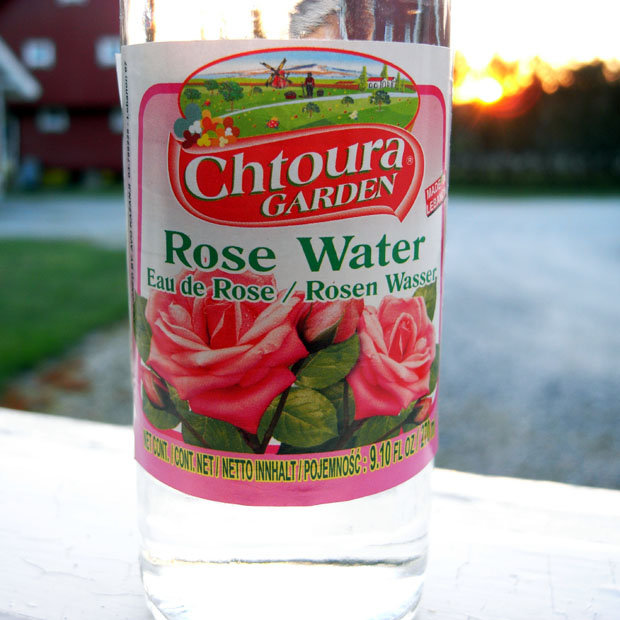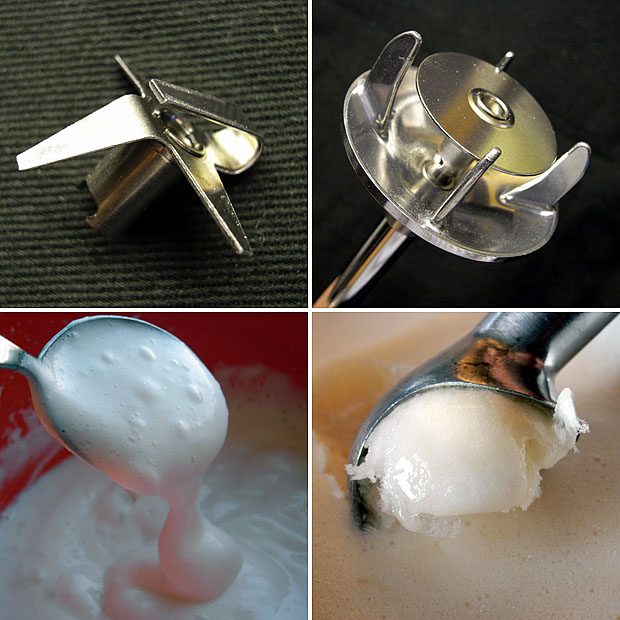
As I mentioned in the previous post I put the leftover rose froam from TGRWT #16 in the freezer and was surprised by the result. Inspired by this I thought I would extend this and substitute apple juice for water for TGRWT #17. As apple juice is quite sweet I started off with 20 g sugar, but once frozen it lacked sweetness and even was a litte icy, so I upped the amount to 40 g. The picture above may suggest that the foam could be served for dessert, but read the verdict before you make huge amounts of the foam.
Frozen rosy apple foam
2.1 g xanthan (0.50%)
3.6 g methyl cellulose (0.85%)
40 g sugar
6.5 g rose water
300 g apple juice
70 g lemon juice
Grind xanthan, methyl cellulose and sugar in mortar (easier dispersion of hydrocolloid in water). Mix liquids in a bowl and disperse sugar and hydrocolloids into solution with a hand held immersion blender. For better foam production change to tilted disk attachmend or use an electric whisk. Freeze.

Verdict: Aroma wise I was quite satisfied and even my wife liked it. The rose flavor was pronounced but not overwhelming and balanced nicely with the apple. I had to use quite a lot of lemon juice though to get it acidic enough for my taste. The texture was not as smooth as I had hoped for however. It was a little icy and even brittle when scooped and certainly need improvement if I’m to make this again. Another disappointment was the aftertaste – it was actually not good at all. I suspect that it’s one of the hydrocolloids. Anyone have similar experiences? As it is now I would not serve the frozen foam as a dessert because of the aftertaste. But it could work well as an element in a dish. And I was thinking if adding a little fat, for instance as cream, could help both the texture and remedy the aftertaste?

I only used my new Bamix for dispersion and whipping this time. First with the knife attachment for dispersion (top left) and then with the tilted disk for whipping (top right). Compared with the rose foam I made for TGRWT #16 using a conventional hand mixer the bubble size was more non-uniform when using the Bamix (bottom left). The foam scoops nicely when frozen, but texture leaves a little to desire (bottom right).

Try it with a lecithin foam. I’ve served frozen lecithin foams at a few dinner parties to very positive responses – there’s no unpleasant aftertaste there, and I tend to find that lecithin produces a much lighter foam compared to xanthan.
Why are you using the methyl cellulose in there, by the way? I’ve just used xanthan solo for foams before – I take it the methyl cellulose improves it in some way?
Why did you use grams for the liquids and not milliliters? Shouldn’t they be roughly equivalent anyway?
Hugh: At room temperature you get a thick, stable foam when using xanthan and methyl cellulose which was what I was after in the first place. It is this type of foam that I tried to freeze. This foam is very different from the light air you get when using lecithin. When used alone xanthan does not foam very well. So the reason I use methyl cellulose is really to get a good foam. The xanthan/methyl cellulose recipe is loosely based on Chad’s lemon whip which I’ve included in “Texture – A hydrocolloid recipe collection”.
Nessie: With a balance you can use whatever glassware or cup you have at hand. This often saves a little washing up 🙂 But you are right – for all practical purposes in the kitchen you can assume that 1 mL = 1 g (and 1 L = 1 kg).
Hello there all,I am in Ireland and cant get any methyl cellulose,the stuff the chemist had was dyed pink and in tablet form. Would any one know any web sites in the Eu where I can get some
Cheers
In the drop down menus clikck Link => Suppliers
It brings up this page: http://blog.khymos.org/links/suppliers/
[…] Having discovered that the foam could be frozen, for TGRWT #17 he chose to develop it into a frozen ‘rosy apple foam’ dessert. The verdict: the frozen foam had a very nice aroma and a good rose-apple flavour balance. However, […]
Oh man, frozen foams. I made one recently. “Unpleasant” was the feeling you had between the “oh, weird” phase and “EW GET IT OUT OF MY MOUTH” phase, which unfortunately lasted the better part of the experience.
But! I think I’ve leaned since. Instead of a whipped foam, have you considered charging it with nitrous oxide? You could probably get a tighter grain to your foam. Also, since you’re freezing it, a bit of ice cream stabilizer should help. I’ve had great results with a variation on the Migoya blend, using gelatin, LM pectin, LBG and guar. Adding some glucose should also help in the texture department. I’d think of this as less of a foam than a sorbet or semifreddo.
As for taste, if you upped the gelatin of the stabilizer blend and added lecithin, you should still get a similar texture. I haven’t tried it, so maybe this is just late night rambling/BS, but I’m amazed at how my foams are much thicker and smoother with a cream whipper.
And while I’m throwing suggestions around in a completely unsolicited manner, have you tried orange blossom water as well? I realize that it isn’t the theme, but the flavors are so similar I’m convinced there must be similar volatile compounds. On the other hand, it doesn’t have the sort of soapy notes of rose blossom water. They also seem to have great synergy in savory dishes.
Martin,
Thanks to alex from ideas in food I think the problem is that sugars seem to inhibit the hydration of methylcellulose, resulting in a smell and taste not unlike cork. It is very off putting to say the least. When making foams in this manner it is important to fully hydrate the gum first, before adding any sugar, while keeping the percentage ratios for the finished material in mind. I think even the sugar present in the apple juice would be enough to ruin the final product. Try making 25% of the solution water, hydrate the mc and xanthan in that, then incorporate the sweeter elements. Hope it helps. Thanks so much for the blog.
Martin,
off topic from rose and apple…
was doing some reading on taste potentiation and came across a book of interest, ‘Spice science and technology’, K.Hirasa, M.Takemasa, 1998, ISBN 0824701445. there is a chapter called ‘The Patterning Theory of Spice Use’, which focuses on pairing of like ingredients (spices > foodstuffs), based on synthesis of like-taste/smell-features of similar components. it is quite interesting, made me think a lot of your work in the TGRWT series.
thanks for you work in this blog. i learn everytime i read.
and the hydrocolloid collection is fantastic.
regards.
Alfa-Aesar sells many grades of methyl cellulose. Hydroxypropylcellulose may be an alternative.
Noticed many ice crystals in the frozen foam picture, making for a rough mouth-feel. Suggest adding fish anti-freeze glycoproteins, like the one used by Unilever in ice creams to make a smoother and creamier frozen foam.
Hi Martin,
I just wonder what different between methyl E460 and F50? Are they can be substitute? Thanks in advance.